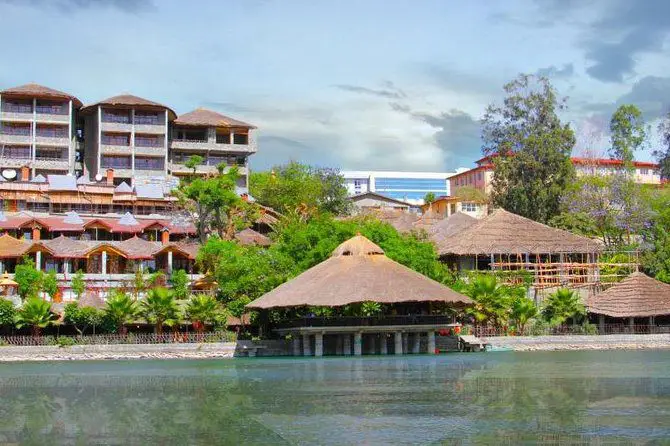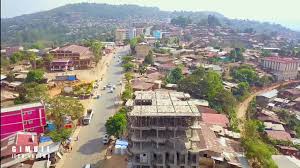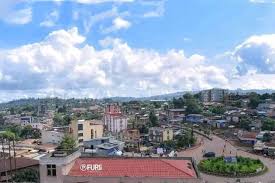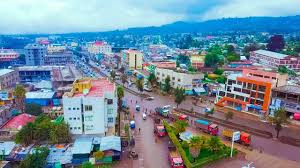Bishoftu, known historically as Debre Zeit, is a charming town located in the Oromia region of Ethiopia, southeast of the capital city Addis Ababa. With its scenic beauty, numerous crater lakes, and rich historical significance, Bishoftu has grown into one of Ethiopia’s most popular tourist destinations and a beloved retreat for residents of the bustling capital. This serene town, often referred to as “The City of Seven Lakes,” is a blend of natural beauty, history, and modern development.
Geography and Location of Bishoftu
Bishoftu is located approximately 47.9 kilometers (about 30 miles) southeast of Addis Ababa, making it a convenient escape for those seeking tranquility and a break from urban life. The town is nestled in the East Shewa Zone at an elevation of around 1,920 meters (6,300 feet) above sea level, which grants it relatively mild weather year-round compared to other regions of Ethiopia.
Geologically, Bishoftu sits in a volcanic field with its landscape shaped by Holocene lava flows, tuff rings, cinder cones, and maars. Some of the maars are filled with water, forming the famous crater lakes for which Bishoftu is well-known. These include Lake Bishoftu, Lake Hora, Lake Bishoftu Guda, Lake Koriftu, and the seasonal Lake Cheleklaka. These lakes, surrounded by rolling hills and lush greenery, contribute to the town’s reputation as a resort destination.
Historical Background of Bishoftu
Bishoftu’s history as a distinct entity began after the Second World War. Before that, the area was known as “Adda” in older accounts. The town’s growth is closely tied to the establishment of the Ethiopian Air Force. In 1946, the air force, which had initially been based at Lideta Airport in Addis Ababa, was relocated to Bishoftu. The town then became a hub for military aviation training and activities. The Swedish involvement in training Ethiopian pilots and building up the airbase is a significant part of Bishoftu’s modern history. The airbase, known as Harar Meda, remains one of the most important military facilities in Ethiopia.
The town’s name was officially changed from Debre Zeit to Bishoftu in the late 1990s, reflecting the local Oromo name for the area. The name “Bishoftu” derives from the Oromo word “bishaanooftuu,” which roughly translates to “watery,” an apt description given the numerous lakes in the region. The town’s previous name, Debre Zeit, is an Amharic phrase meaning “Mount of Olives,” which had been in use since the mid-20th century.
The Lakes of Bishoftu
One of the primary attractions of Bishoftu is its series of crater lakes, which are of volcanic origin. These lakes are not only breathtakingly beautiful but also hold cultural, historical, and recreational significance.
Lake Bishoftu
Also known as Lake Hora, this lake is one of the most popular and iconic landmarks of Bishoftu. Its deep blue waters are surrounded by lush vegetation, and the area is a haven for birdwatchers, with many species of waterfowl calling the lake home. Lake Hora is also the site of an annual festival that draws visitors from across the country.
Lake Babogaya
Located close to Lake Hora, this serene lake is smaller but equally beautiful. Its calm waters are perfect for boating, and it is surrounded by resorts and lodges offering peaceful retreats.
Lake Koriftu
Known for its luxurious resorts, Lake Koriftu is another major draw for tourists. The lake’s clear waters and the nearby Kuriftu Resort and Spa provide a perfect blend of natural beauty and modern comfort. Visitors can enjoy a range of activities, from spa treatments to water sports.
Lake Cheleklaka
Unlike the other lakes, Lake Cheleklaka is seasonal, with water levels fluctuating throughout the year. It is an important stop for migratory birds, particularly flamingos, making it a popular spot for birdwatching during the right season.
These lakes are not only popular tourist spots but also vital to the local ecosystem. They provide habitats for various plant and animal species and are integral to the environmental health of the region.
Climate and Weather of Bishoftu
Bishoftu enjoys a temperate climate due to its elevation. The town experiences two main seasons: the rainy season, which lasts from June to September, and the dry season, which extends from October to May. During the rainy season, the landscape becomes lush and green, with frequent showers that help maintain the vibrant environment. In contrast, the dry season brings clear skies and warm, sunny days, though temperatures remain comfortable due to the town’s altitude.
The average temperature in Bishoftu ranges between 16°C (60.8°F) and 24°C (75.3°F), making it a pleasant destination year-round. The town’s balanced climate, along with its scenic lakes and rolling hills, makes it an inviting place for both residents and visitors.
Cultural and Economic Significance
Bishoftu’s proximity to Addis Ababa and its natural beauty have contributed to its development as a resort town. The hospitality industry plays a significant role in the local economy, with several hotels, resorts, and lodges catering to tourists and residents seeking a peaceful getaway. The town is also known for hosting conferences, retreats, and events, given its idyllic setting and modern facilities.
Additionally, Bishoftu is home to the Ethiopian Air Force and the Harar Meda Airport, which serves as a military base. The town’s economy also benefits from agricultural activities, with fertile land surrounding the lakes supporting the cultivation of crops and livestock farming.
The town has seen significant growth in recent years, with the population estimated to be over 197,000 as of 2021. This growth has brought with it increased infrastructure development, including improved roads, healthcare facilities, and educational institutions.
Tourism and Recreation
Tourism is one of the most important economic drivers for Bishoftu. The town’s lakes, combined with its temperate climate and proximity to Addis Ababa, make it a popular destination for both international tourists and locals. Visitors come to enjoy the natural beauty, engage in water sports, go birdwatching, and relax at one of the many resorts and lodges that dot the lakeshores.
Several luxury resorts, such as the Kuriftu Resort and Spa, offer a range of services, from spa treatments to boat rides, making Bishoftu a perfect retreat for those looking to unwind. For the more adventurous, there are hiking opportunities around the lakes and nearby mountains, including Mount Yerer, which offers stunning views of the surrounding landscape.
Historical Landmarks and Modern Development
Bishoftu is not only known for its natural beauty but also for its historical and cultural landmarks. One such landmark is the palace of Emperor Haile Selassie, built as his weekend retreat. The palace, named “Fairfield,” was a personal favorite of the Emperor, who spent much of his leisure time there. This palace is a reminder of Bishoftu’s historical significance during the reign of Haile Selassie.
The town has also played a pivotal role in Ethiopia’s military history, particularly in the development of the Ethiopian Air Force. The Harar Meda Airbase is still operational and serves as a reminder of the town’s contribution to the country’s defense forces.
In terms of modern development, Bishoftu has grown rapidly in recent years. Its infrastructure has improved significantly, with better roads, healthcare services, and schools being built to accommodate the growing population. The town is also connected to the Addis Ababa–Djibouti Railway, further enhancing its role as a transport and logistics hub.
Conclusion
Bishoftu, with its stunning crater lakes, mild climate, and rich history, stands as one of Ethiopia’s most captivating towns. Its blend of natural beauty and modern development makes it a popular destination for tourists, residents, and businesses alike. Whether it’s enjoying a peaceful retreat by the lakes, exploring the town’s historical landmarks, or taking part in local festivals and events, Bishoftu offers something for everyone.
As the town continues to grow and develop, it remains a cherished location for those seeking a balance between nature and modern comforts. Its role in Ethiopia’s history, particularly in aviation, and its status as a resort destination ensures that Bishoftu will continue to be a significant and beloved part of the country for years to come.





